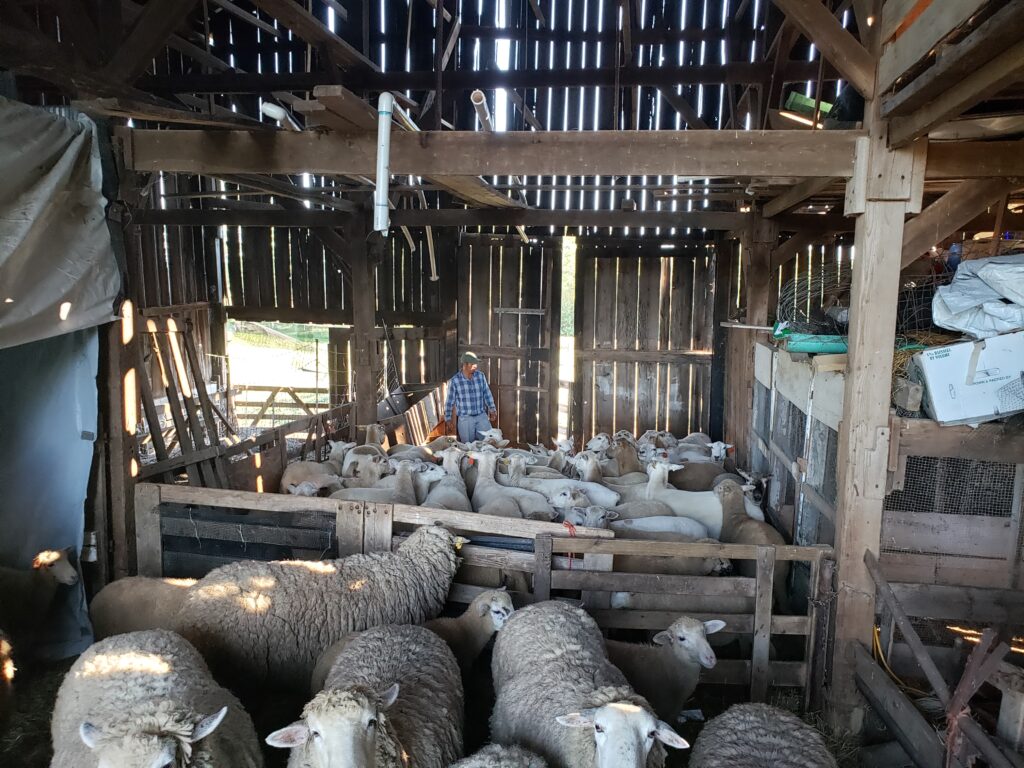Shearing sheep is a lost art, mostly because it is hard work. Over the last 20 years, we have been dependent on these craftsmen (every one I’ve ever met were men) to come to the farm with their specialized tools to remove the wool from our animals in an efficient manner. I have personally shorn a few ewes over the years with marginal success in completing the task at hand and a sore back for days. Suffice it to say, when the sheep shearer calls to schedule us in, everything else can wait.
We have two breeds in the flock of sheep here at Elmwood Stock Farm: Dorsets, an old English breed, and Katahdins, a hair sheep.
Dorset Sheep
John has ribbons from his showmanship days as a teenager. The Dorsets on the farm today are offspring of those bloodlines. Sheep are known to provide meat and wool; for us, we have selected for meat quality in our grass-fed-nutrition program, rather than raise them for the wool. The type of wool our Dorsets have is considered of lower quality than Merino, Rambouillet, Corriedale and that of other fiber breeds. Our Dorsets make the kind of scratchy wool sweaters and blankets that met the utility for Army uniforms in the Civil War and World Wars I and II. All that is to say: The wool is only worth a nickel a pound; the reason for shearing is the welfare of the animals.

Shearing Sheep
While we picture the wool keeping the sheep warm in winter, it also helps to keep them cool in the summer. Too much wool, though, impedes their ability to regulate their body temperature like this. Yet lambs emerge from the warmth of the womb with very little covering them, and every shearer who has ever been here has said it makes no difference to the sheep if it’s shorn in freezing weather.
We like to shear the ewes just before lambing—delayed this year because of COVID-19—so the newborn lambs can more easily find the teat to suckle within minutes of being born. It is an absolute miracle every time and hard to watch when the tender little lamb struggles to nose through unnecessary wool in search of sustenance.
The art of shearing comes into play in getting a 150-pound beast to hold still, and in the right position to run the clippers over its entire body. A good shearer has a knack for holding the animal in such a way that they feel safe. Similarly, horse people say the horse can tell when the handler or rider is scared and will act out accordingly. (This happened to me at day camp when I was 10 or 12, because I was scared, and the horses enforced this into my psyche ever since.)
Sheep are unique in that when you flip them up to where they are sitting on their butt, back legs splayed out and leaning their back against your legs, they generally sit still. (Evolution, anyone?) In this position, we also care for their feet and replace identifying ear tags.
The shearer starts with the sheep’s chest and belly before heading to the most sensitive parts between their hind legs. Thrashing around would not be good for the sheep or the shearer, and they somehow seem to understand this. After the soft underbelly is safely cleaned up, the animal is rolled to one side, then the other, where long sweeping strokes clear the sides and back rather quickly. And this all does need to happen quickly so as not to stress the animal and tire out the shearer more than necessary.
Each year that I would shear a sheep, in my younger days, it took about 30 minutes. The ewe was breathing hard, I was sweating like a pig so much the clippers were shocking my hands, and my back hurt. That’s why I change my schedule when the shearer calls.
Katahdin Sheep
About four years, ago we acquired a different breed of sheep called Katahdins. They were developed over time in the shadows of Mt. Katahdin in Maine, and known as ‘hair’ sheep. I suppose it is still wool, but it looks more like hair that they naturally shed each spring. Viola, no shearing necessary. We have found Katahdins to be good mothers, and the meat is of high quality. In fact, since they are a smaller-framed animal, they have shown superior performance in our grass-based pasture-finishing program.
The responsibility of caring for food animals comes with great cost. This living, breathing, reproductive mammal is totally dependent on us for her well-being. I have learned how to manage their nutrient requirements to avoid most problems (this works for humans, too) and figured out how to avoid parasite problems with smart pasture rotation rather than invasive chemical treatments. We help them in their time of need, like when birthing triplets, if indicated. We hire a shearer who is skilled in their trade to take care of the wool.
For now, we have some of each breed—Dorset ewes and rams and Katahdin ewes—each with their positive attributes. We also have some wool fleeces that we may send off to be cleaned and spun into yarn. (You’ll hear more about that, if we do.) Previous years’ wool now insulates the brooder room to keep newly hatched chicks and turkey poults warm. We hope to always keep some wool sheep out here on Elmwood Stock Farm, as long as a talented shearer is available. —Mac Stone



Made with 
